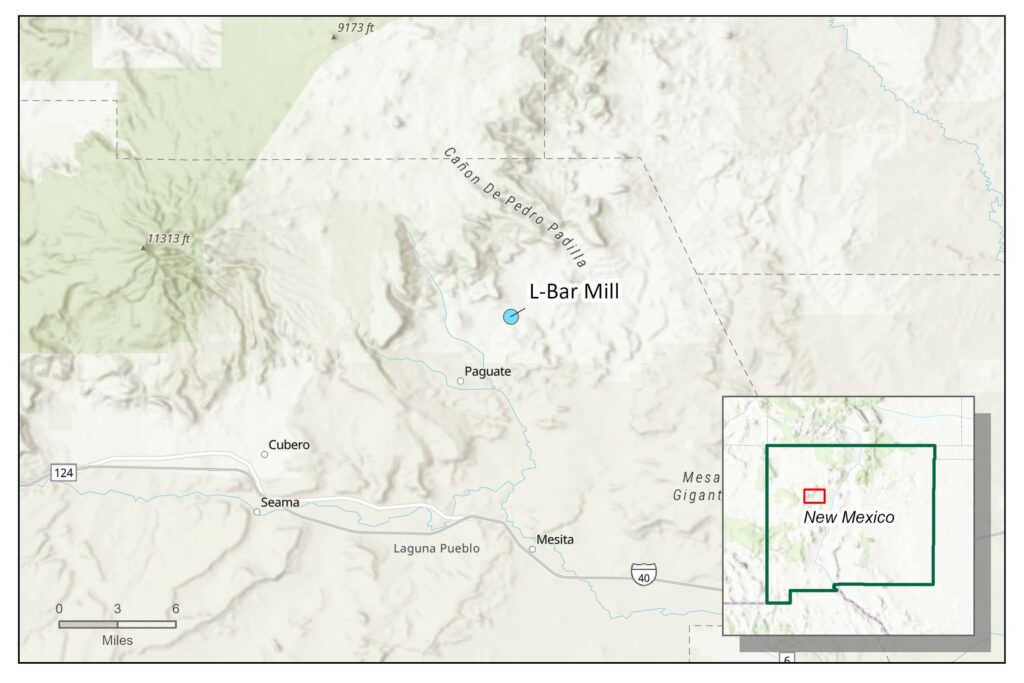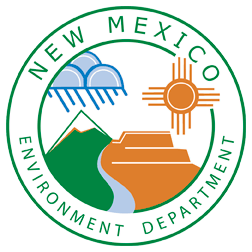Location
The L-Bar mill is located in Cibola County, approximately 47 miles west of Albuquerque, New Mexico, and 10 miles north of Laguna Pueblo.

Ownership and History
The L-Bar mill was previously owned and operated by Sohio Western Mining Company (SWMC). The site consists of a 100-acre tailings disposal cell containing around 2.1 million tons of tailings, located on a 738-acre parcel. SWMC conducted uranium mining and milling operations from 1997 to 1981 at the L-Bar Ranch site in Cibola County, New Mexico. About 2.1 million tons of ore were processed at the mill. The L-Bar mill used a sulfuric acid-leach process to extract uranium from the ore. The milling operations resulted in approximately 700,000 cubic yards of tailings, which SWMC disposed of in a 100-acre impoundment. L-Bar was transferred to the U.S. Department of Energy Office of Legacy Management (DOE-LM) in 2004 for long-term custody and remains under DOE-LM management and regulation.
Reclamation and Regulatory Jurisdiction
Milling activities produced radioactive tailings and liquid wastes, which were pumped in slurry form into an unlined, onsite tailings impoundment for disposal. During mining activities, SWMC released nickel, selenium, and uranium from the tailings facility, causing groundwater contamination. Surface reclamation and cleanup took place from 1986 to 2000. Reclamation activities included re-grading tailings, excavating diversion and drainage channels, placing radon barriers, capping tailings basins, pumping and treating groundwater, and decommissioning the mill.
SWMC demolished all aboveground structures, including the mill buildings, and completed site surface reclamation in 2000.
The site held an NMED discharge permit (DP-150) as well as a U.S. Nuclear Regulatory Commission (NRC) site-specific permit (SUA-1472), both of which have been terminated. The site currently holds an active NRC general license for the custody and long-term care—including monitoring, maintenance, and emergency measures—necessary to ensure uranium and thorium mill tailings disposal sites will protect public health, safety, and the environment after closure. Following all closure activities, SWMC acquired alternate concentration limits (ACLs) from the NRC in 1999. In January 2004, NMED notified SWMC that it terminated the DP-150 and implemented alternative abatement standards to align with the NRC ACLs. In September 2004, SWMC transferred ownership of the L-Bar site to DOE-LM, which also terminated the NRC Source Materials License SUA-1472.
The L-Bar site is under the jurisdiction of Title II of the Uranium Mill Tailings Radiation Control Act of 1978 (UMTRCA), which authorized the remediation of uranium mill tailings inactive prior to 1978. Title II of UMTRCA (regulated under Title 10 Code of Federal Regulations Part 40, Appendix A), specifies that once reclamation is complete, long-term custody of the site is the responsibility of the federal government or the host state. The state of New Mexico declined to become responsible for the site, so DOE-LM became responsible.
Timeline for Completion of Cleanup Activities
The New Mexico Office of Natural Resources Trustee (ONRT) worked with the Cebolleta Land Grant to implement groundwater protection restoration projects that upgrade wastewater management systems (including treatment and sewer systems) for the nearby communities of Bibo, Cebolleta (also spelled Seboyeta in published documents), and Moquino.
The NRC granted final cleanup approval in 2001, as well as approval of ACLs for uranium and selenium. The New Mexico Water Quality Control Commission approved alternative abatement standards for chloride, sulfate, nitrate, total dissolved solids, uranium, and selenium in 2003. Based on groundwater sampling trends and computer modeling, the remaining contaminated groundwater is not expected to migrate beyond the site boundary. In 2004, SWMC transferred ownership and maintenance of the site to DOE-LM.
DOE-LM manages the disposal site according to a site-specific Long-Term Surveillance Plan to ensure the disposal cells continue to protect against contaminants releasing into the environment. DOE-LM conducts annual inspections of the site to evaluate the conditions of surface features, performs site maintenance, and monitors groundwater to ensure that contaminated groundwater does not exceed concentrations approved in the ACL agreement. In accordance with 40 Code of Federal Regulations 192.32, the disposal cells are designed to be effective for 1,000 years, to the extent reasonably achievable, and for at least 200 years in any case. The general license has no expiration date, and DOE-LM’s responsibility for the site will last indefinitely.
Coordination Between State and Federal Agencies
The site is currently monitored and managed by the LM under Title II of UMTRCA. The ONRT has developed and implemented the site restoration plans.
Anticipated Funding Requirements
ONRT prepared and implemented a restoration plan for the L-Bar site using funds from a settlement with SWMC for alleged damages to the natural resources of the state of New Mexico. The amount of the settlement was $35,174.77, of which SWMC paid $29,830 to ONRT to replace, restore, or acquire the equivalent groundwater natural resources. SWMC paid the difference of $5,344.77 to ONRT and the New Mexico Attorney General to reimburse these entities for costs incurred to assess the damage.
Disclaimer
Site reviews in this report provide the reader with a general history and status of permitted mines and mills. For brevity, they may not provide all relevant details or agency actions related to each site.

